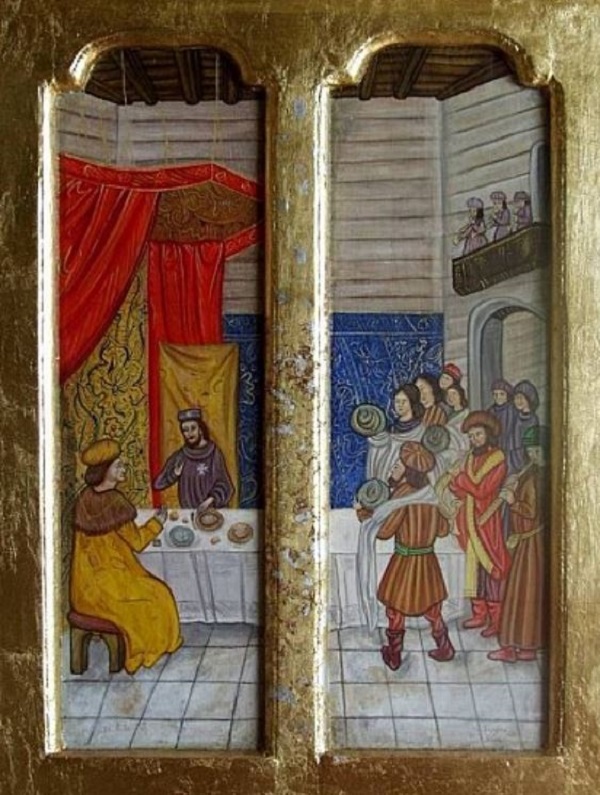THE HOUSE OF DJEM [03]

ON OUR MAP: 03
Very near the Archaological Museum, a knightly mansion, hidden in a covered side alley of the Street of the Knights, on the right side of the way to the Palace.
Glass panels set in the floor of this thoroughly excavated medieval structure expose columns of one of the city’s main ancient streets.
It was on the premises of this mansion that the Ottoman prince Djem in 1482 benefited from the “hospitality” of Grand Master d’Aubusson.
Djem, son of the Sultan Mehmet the Conqueror (of Constantinople and Byzantium), arrived in Rhodes fleeing from his brother who wanted his head.
Scroll to the end of this page if you are interested in Djem’s turbulent life.
ONLY SUNDAYS: 12:30 - 15:00
ENTRANCE: Free
ADDRESS: Street of the Knights, next to the Inn of the Tongue of France
TEL: 22413 65257
Djem's short life in a few lines:
In 1481, the year after his unsuccessful siege of Rhodes, Mehmet died.
His succession was contested between two of his sons: Djem (or Cem or Sizim) and his older half-brother, who went on to rule as Beyazit II.
Djem asked for refuge in Egypt, where the Mamluk leader Kasim Bey received him with honour.
After rejecting his brother’s generous offer to stop competing for the throne, he launched a campaign against him and was soon defeated.
He fled to Rhodes in July 1482 and was received with great ceremony.
When there, he negotiated with the Knights of St John a political asylum in their hands, promising perpetual peace between the Ottoman Empire and Christendom, if they helped him overthrow his brother.
Grand Master d’Aubusson welcomed the possibility: The prince’s presence on the island, if handled correctly, could guarantee some measure of peace with the Turks.
D'Aubusson, however, realized that conflict with Bayezid would be imprudent, so he secretly approached him, concluded a peace treaty and a separate agreement on Djem's captivity.
He promised Bayezid to detain Djem in return for an annual payment of 40,000 ducats.
To seal the deal, the Sultan gifted to the Order of the Knights of St. John one of Constantinople’s most precious relics: the right arm of St John the Baptist, which had been kept in Constantinople since the 10th century.
The prince became a well-treated prisoner in Rhodes and was later sent “for greater safety” to the d'Aubusson family castle in the Auvergne.
He was now a hostage, as well as a potential pawn.
Some European leaders (including Pope Innocent VIII), as well as the Mamluk Kasim Bey, hoped to use him for causing turmoil in the Ottoman empire.
Others, such as the Knights of Saint John, the Venetians, the king of Naples, and the new Pope Alexander VI, viewed his presence in Europe as a deterrent to Ottoman aggression and an opportunity for profit.
Bayezid sent ambassadors and spies to the West to assure that his rival was detained indefinitely, and he even attempted to eliminate him through assassination.
He negotiated both with D'Aubusson to have Djem returned to Rhodes, and with the new French monarch, Charles VIII, to have him kept in France.
When the king of Hungary and Pope Innocent VIII sought custody of the prince, the Pope prevailed. Djem arrived in Rome in March 1489.
Bayezid, in return for the prince's incarceration, agreed to stay away from Rhodes, Rome and Venice.
He also paid the Pope 120,000 crowns (more than all annual sources of the papal revenue combined), sent him a relic of the Holy Lance which allegedly had pierced the side of Christ, one hundred Moorish slaves and promised him an annual fee of 45,000 ducats (10,000 of which were for the Knights of Saint John).
Detail: The costs of the Sistine Chapel were mostly paid with funds from the Ottoman ransoms.
However, Djem was too valuable a hostage to survive for long: Alexander VI Borgia, the new Pope, imprisoned him.
In 1494, Charles VIII of France, invaded Italy to take possession of the kingdom of Naples, and announced a crusade against the Turks.
He compelled the Pope to surrender Djem, who left Rome with the French army in January 1495.
The prince died in Capua, a hostage and under the command of king Charles, on the military expedition to conquer Naples. He was only 35 years old.
Some attribute his death to poison.
Bayezid declared national mourning for three days and requested to have Djem’s body for an Islamic funeral.
Four years later, and after more gold had been paid, the prince’s body was finally brought to the Ottoman lands.
Djem was buried in Bursa, in the beautiful Muradiye complex, alongside his other brother, Mustafa.